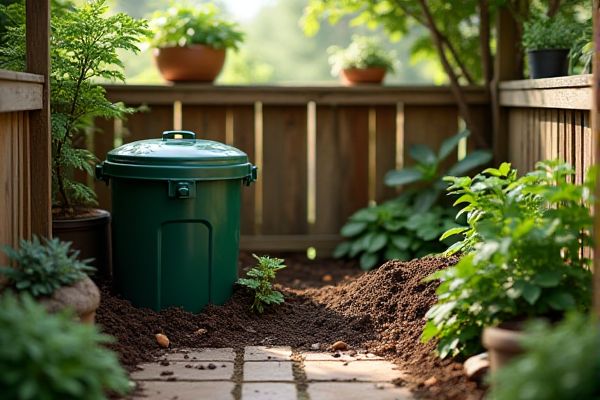
A compost tumbler offers faster decomposition through regular turning while a compost bin relies on natural microbial activity and requires manual mixing for aeration. Understanding the differences can help you decide which option best suits your gardening needs and lifestyle, so explore the rest of the article to make an informed choice.
Table of Comparison
| Feature | Compost Bin | Compost Tumbler |
|---|---|---|
| Design | Stationary, enclosed container | Rotating drum for easy mixing |
| Composting Speed | Slow to moderate (3-6 months) | Fast (1-3 months) due to active aeration |
| Ease of Use | Simple setup, requires manual turning | Easy turning mechanism for mixing waste |
| Capacity | Typically larger volume, 20-50 gallons | Smaller volume, usually 5-20 gallons |
| Odor Control | Moderate, depends on aeration & mix | Better odor control with sealed drum |
| Pest Resistance | Moderate; may attract pests if not sealed | High; sealed design keeps pests out |
| Cost | Generally lower price ($30-$100) | Higher price point ($70-$200) |
| Maintenance | Requires manual aeration and monitoring | Less maintenance due to tumbling action |
Introduction to Compost Bins and Tumblers
Compost bins and tumblers both offer efficient methods for recycling organic waste, but they differ in design and functionality. Compost bins typically provide a stationary container that allows natural decomposition over time, while tumblers are designed for easy rotation, speeding up the aeration and breakdown process. Choosing the right system for your garden depends on your space, composting speed preferences, and maintenance style.
How Compost Bins Work
Compost bins work by creating an enclosed environment where organic waste decomposes through microbial activity, temperature regulation, and moisture control. They retain heat and moisture to accelerate the breakdown of materials like kitchen scraps and yard waste, producing nutrient-rich compost. Proper aeration is maintained in compost bins to facilitate oxygen flow, essential for aerobic decomposition and minimizing odors.
How Compost Tumblers Work
Compost tumblers work by rotating the enclosed drum to mix organic waste, which accelerates decomposition through improved aeration and moisture distribution. Designed to reduce labor and odor, tumblers provide a controlled environment that minimizes pests and allows faster breakdown compared to traditional stationary compost bins. Regular tumbling ensures consistent oxygen flow, promoting microbial activity essential for efficient composting.
Key Differences Between Bins and Tumblers
Compost bins typically offer larger capacity and passive aeration, making them suitable for slower, steady decomposition of garden waste, while compost tumblers provide active aeration through regular rotation, accelerating the breakdown process. Bins often require manual turning with tools like pitchforks, whereas tumblers enable easy mixing by simply spinning the container, improving oxygen flow and reducing composting time. Your choice depends on space, composting speed preferences, and ease of maintenance, with tumblers favored for quicker results and bins preferred for larger volumes.
Comparing Composting Efficiency
Compost tumblers accelerate decomposition by providing superior aeration and ease of mixing, resulting in faster nutrient-rich compost compared to traditional compost bins. Compost bins retain moisture and heat well but often require manual turning, which can slow down the breakdown process. Choosing a tumbler can enhance your composting efficiency by promoting quicker microbial activity and reducing maintenance time.
Space and Placement Considerations
Compost bins typically require more space and are best placed in a dedicated garden corner, while compost tumblers are compact and can fit conveniently on patios or smaller yards. Tumblers offer better aeration through easy rotation, making them suitable for limited spaces where odor control is important. Choosing the right container depends on your available space and whether you need a system that can be easily moved or turned for efficient composting.
Maintenance and User Effort
Compost bins require regular turning with a pitchfork or shovel to aerate the materials, demanding consistent physical effort and time commitment. Tumblers feature a rotating drum design that simplifies aeration by allowing users to spin the contents easily, significantly reducing manual labor and speeding up the composting process. Maintenance for tumblers includes occasional lubrication of moving parts, whereas bins primarily need monitoring moisture levels and occasional mixing.
Cost Comparison: Bin vs Tumbler
Compost bins typically cost between $20 and $100, making them a more budget-friendly option for home gardeners, while compost tumblers range from $80 to $200 due to their rotating mechanism and ease of use. Bins are often made from simple plastic or wood, resulting in lower initial expenses but potentially higher labor costs, whereas tumblers offer faster composting times, potentially saving effort and cost over time. Considering maintenance and longevity, tumblers may justify their higher price by providing efficient aeration and quicker decomposition, enhancing overall compost production.
Environmental Impact and Sustainability
Compost bins and tumblers both reduce landfill waste by converting organic materials into nutrient-rich soil, but tumblers accelerate decomposition through improved aeration and mixing, leading to faster results. You can achieve greater environmental benefits with a tumbler, as it minimizes methane emissions by promoting aerobic conditions, whereas static bins may decompose anaerobically if not properly managed. Choosing between the two impacts sustainability; tumblers optimize composting efficiency while bins offer simplicity for steady, long-term organic recycling.
Choosing the Right Compost Solution for Your Needs
Compost bins offer a straightforward, cost-effective way to manage organic waste, ideal for homeowners with limited space and a slower composting process. Tumblers provide faster decomposition through easy rotation, making them suitable if you want quick nutrient-rich compost for your garden. Assess your available space, desired composting speed, and maintenance preferences to choose between a compost bin or tumbler for your sustainable gardening needs.
 homyna.com
homyna.com